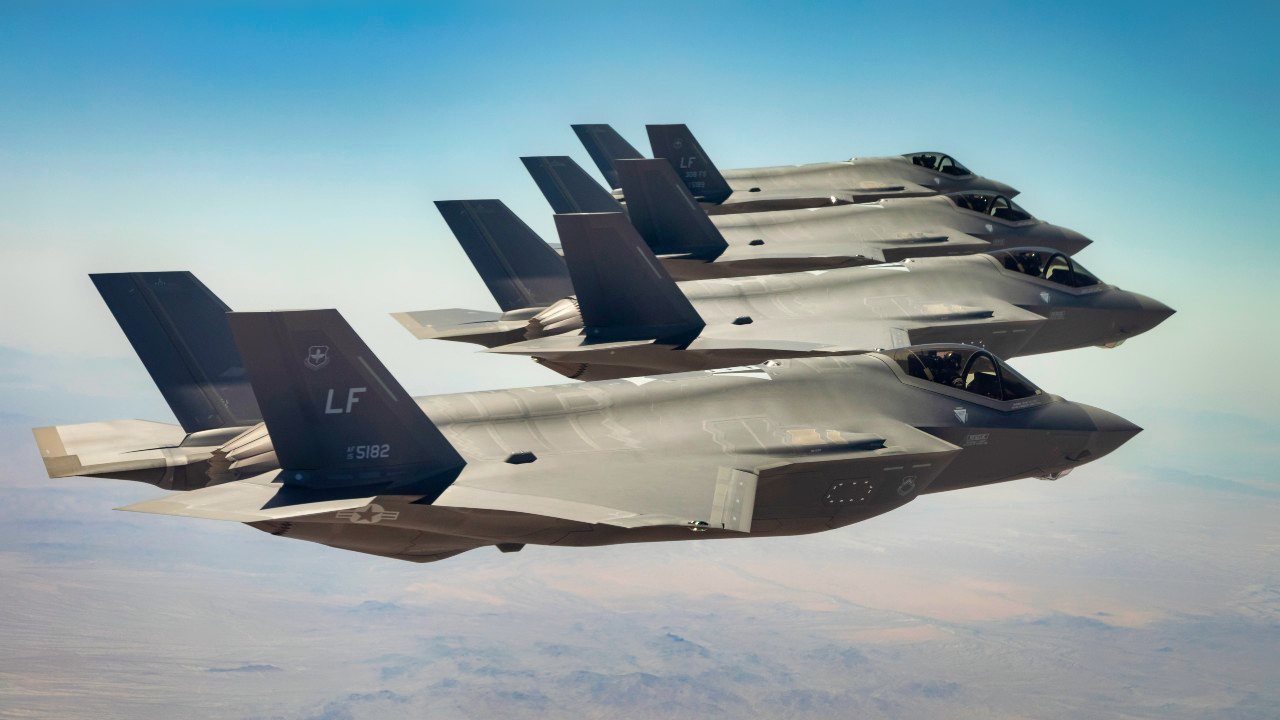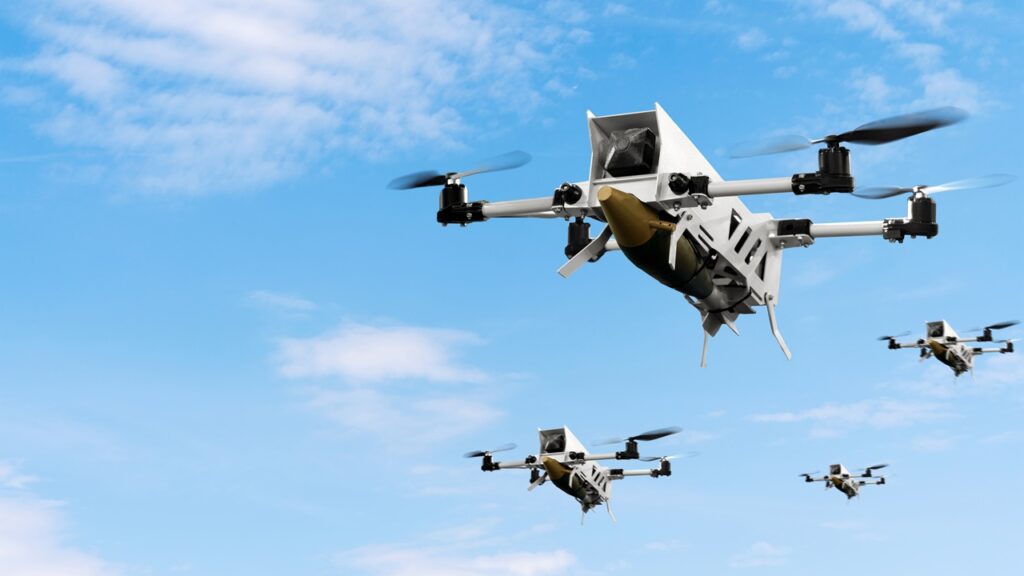F-22 vs. F-35 – The Key Points and Summary
- Mission Focus: The F-22 was built for air superiority and excels in dogfighting, while the F-35 was designed for versatility, balancing air-to-air, air-to-ground, and electronic warfare missions.
- Performance Trade-offs: The F-22 is faster and more agile, topping out at Mach 2.2 compared to the F-35’s Mach 1.6. However, the F-35 is easier and cheaper to upgrade and maintain.
- Weapons Capability: The F-35 carries a broader array of munitions, including nuclear weapons and anti-ship missiles. The F-22 focuses on air-to-air engagements with precision.
- Strategic Value: The F-35 serves across all U.S. military branches and multiple allied nations. The F-22 remains exclusive to the U.S. Air Force but dominates in advanced aerial combat scenarios.
The Characteristics of the F-22
The F-22 Raptor set a new benchmark for stealth fighter technology when it entered service. Its shape, coating, and internal weapons bays help it evade radar detection, giving it a major edge in contested airspace. What truly sets it apart, though, is its supercruise ability, which allows it to fly at supersonic speeds without using fuel-hungry afterburners.
Inside the cockpit, advanced avionics and sensor fusion systems give pilots a detailed picture of the battlespace. This makes it possible to detect, track, and target enemy aircraft long before being seen. Combined with its blistering speed and maneuverability, the F-22 is designed to dominate the skies in any dogfight or beyond-visual-range scenario.
The Characteristics of the F-35
The F-35 Lightning II is the definition of multi-role adaptability. It comes in three variants: the F-35A for conventional airfields, the F-35B for short takeoff and vertical landing, and the F-35C for aircraft carrier operations. This tri-service approach makes the F-35 a universal asset across the Air Force, Navy, and Marine Corps, as well as allied forces abroad.
Its strength lies in sensor fusion, seamlessly pulling data from a network of sources into a single interface. Pilots can act on real-time intel, making the F-35 not just a fighter but a flying command center. Its stealth design, while optimized for ground attack, still supports potent air-to-air combat. And with its advanced communications and networking capabilities, the F-35 is built for modern, connected warfare.
F-22 vs. F-35: How Do They Compare?
At their core, the F-22 and F-35 reflect two very different design philosophies. The F-22 was built to achieve complete air dominance with unmatched speed, stealth, and agility. The F-35, on the other hand, was designed to serve multiple branches of the military and fulfill a wider range of missions with its flexible, tech-forward approach.
Where the F-22 is a specialized dogfighter that rules the skies, the F-35 is a digital-era workhorse that can carry out strike missions, gather intelligence, and share data across the battlefield in real time.
F-22 and F-35 Have Different Roles
The F-22 and F-35 were built for different missions. The F-22 is a dedicated air superiority fighter, optimized for speed, stealth, and maneuverability in aerial combat. The F-35, by contrast, was designed as a flexible, multi-role platform capable of ground strikes, intelligence gathering, and electronic warfare.
As former Air Force Chief of Staff Gen. Mark Welsh explained, the F-35 “was never designed to be the next dog-fighting machine” but rather a “multipurpose, data-integration platform” built for the air-to-ground arena.
This difference reflects their intended use: the F-22 dominates the skies, while the F-35 connects and supports the battlespace with a broader mission set.
F-22 Is Better at Aerial Combat
The F-22 is faster than the F-35, reaching speeds up to Mach 2.25 compared to the Lightning II’s Mach 1.6. The F-22 is also about 30 percent heavier, but it may still be more maneuverable thanks to its twin Pratt & Whitney F119 engines, which provide around 70,000 pounds of thrust. The F119’s thrust vectoring feature allows the Raptor to make sharper, more agile movements in dogfights, giving it a superior thrust-to-weight ratio.
This raw performance edge makes the F-22 ideal for engaging enemy aircraft at both close and long ranges. When it comes to dominating the skies in a contested environment, the Raptor’s flight dynamics are difficult to match.

F-35 Is More Modernized Than F-22
But the F-35 has other advantages. It requires less maintenance and comes with lower operating costs, which makes it more sustainable over the long term. It is also capable of receiving timely software updates, continuously enhancing its performance and mission capabilities without needing major overhauls.
In many ways, the F-35 functions as a flying computer. Its open architecture allows new technology to be integrated faster, keeping it ahead in an era where digital connectivity and rapid data processing are just as important as speed or firepower.
Different Weapons Load-out
The F-35 has broader weapons capability than the F-22. As a multi-role platform, it supports a wide range of munitions, including nuclear, anti-ship, anti-radiation, and standoff weapons. For example, the F-35A is certified to carry the B61-12 nuclear bomb, and ongoing integration efforts include the AGM-158C LRASM and AARGM-ER for maritime and air-defense suppression missions.
This makes the F-35 a more flexible combat platform. It can take on a variety of mission types using a broad selection of internal and external munitions, whereas the F-22 is more narrowly optimized for air-to-air engagements. The F-35’s expanded payload options make it better suited for strike missions across land, sea, and strategic targets.
That said, the F-22 is not without ground attack capability. It can carry six LAU-142/A launchers for beyond-line-of-sight missiles in its main bays, and two LAU-141/A launchers in its side bays for short- and medium-range missiles like the AIM-9 Sidewinder and AIM-120 AMRAAM. It can also deploy JDAMs or Small Diameter Bombs for precision strikes when needed
On the other hand, the F-22 can carry six LAU-142/A launchers for beyond-line-of-sight missiles. The other two weapons bays have one LAU-141/A launcher each to fire short and medium-range Sidewinders and AMRAAMs. This gives the Raptor an advantage in dogfighting. Ground strike is also possible with precision-guided and unguided bombs.

F-35s Have Robust Ordnance
The F-35 can carry weapons internally or externally for both ground attack and aerial combat. Notable surface strike munitions include Paveway laser-guided bombs and the upcoming SPEAR-3, a land-attack and anti-ship missile. Its external hardpoints can also accommodate the JASSM cruise missile, allowing the F-35 to take on high-value targets from extended ranges.
This flexibility in weapons load-out underscores the F-35’s role as a true multi-role strike platform. It can adapt its loadout based on mission requirements, balancing stealth with firepower by choosing when to carry munitions externally. In contrast, the F-22 has a more limited array of munitions and prioritizes internal storage to maintain stealth during air-to-air engagements.
Compare Stealth Capability
Which airplane has better stealth capability? Both fighters are highly stealthy, but the edge goes to the Raptor. The F-35 features advanced design elements like aligned edges, engine and turbine masking, and serrated panel joints, giving it a reduced radar cross-section compared to traditional jets, as noted by Aero Corner.
Still, the F-22 has a lower radar cross-section overall. Its stealth was engineered specifically for air superiority missions, with more aggressive shaping and radar-absorbent materials. Lockheed Martin has indicated that the F-22’s radar signature can be as small as a steel marble in ideal conditions. While both aircraft can avoid detection better than almost any other plane, the F-22 was purpose-built to be nearly invisible to enemy radar in hostile airspace, giving it a slight advantage in terms of pure stealth performance.
F-22 Raptor vs. F-35 Lightning II: Comparison Table
Below is a side-by-side look at how the F-22 and F-35 compare across key performance categories:
| Feature | F-22 Raptor | F-35 Lightning II |
| Performance & Speed | Top speed: Mach 2.25; supercruise capable at Mach 1.82. | Top speed: Mach 1.6; not supercruise capable. |
| Stealth & Radar Signature | Radar cross-section (RCS): ~0.0001 m²; optimized for air-to-air stealth. | RCS: 0.005–0.3 m²; optimized for air-to-ground stealth. |
| Mission Roles & Capabilities | Air superiority and air dominance. | Multi-role: strike, reconnaissance, electronic warfare, air-to-air, and air-to-ground missions. |
| Cost & Economics | Unit cost: $143 million; estimated total program cost per aircraft: $350 million. Operational cost per flight hour: approximately $59,116. | Unit cost: F-35A – $82.5 million; F-35B – $109 million; F-35C – $102.1 million. Operational cost per flight hour: approximately $41,986. |
| Production & Availability | Total produced: 195 units; exclusively operated by the U.S. Air Force. | Over 1,150 units produced; operated by the U.S. and multiple allied nations. |
| Technology & Avionics | Advanced but older technology with limited upgrade paths. | Highly modern with ongoing software upgrades and system integration. |
| Physical Specifications | Twin-engine configuration; larger airframe. | Single-engine configuration; smaller and lighter design. |
Final Thoughts
The F-22 Raptor and F-35 Lightning II represent two distinct but complementary approaches to modern air warfare. The F-22 is the ultimate air superiority fighter, designed to dominate contested airspace with speed, agility, and stealth. Its unmatched aerial combat performance makes it a powerful deterrent against advanced enemy aircraft.
The F-35, on the other hand, was built for versatility. It bridges the gap between air-to-air and air-to-ground missions while serving across multiple branches of the U.S. military and allied forces. With its advanced sensors, networked communication systems, and ability to carry a wide range of weapons, the F-35 is designed for the interconnected battlespace of the future.
Both fighters are elite in their own domains. Choosing between them depends on the mission at hand.
FAQs
What makes the F-22 Raptor superior in air-to-air combat?
The F-22 excels in air-to-air combat due to its superior speed, high maneuverability, stealth profile, and thrust vectoring engines. These features allow it to outfly and outmaneuver enemy aircraft while remaining undetected at long ranges.
How does F-35 Lightning II multi-role capability compare to F-22?
The F-35 was designed from the ground up to handle multiple mission types, including air-to-ground strikes, intelligence gathering, and electronic warfare. While the F-22 is specialized for air dominance, the F-35 is more flexible, able to adapt to a broader set of combat scenarios.
How many countries have the F-35 Lightning II fighter?
As of now, more than a dozen countries operate or are planning to operate the F-35, including the United States, United Kingdom, Japan, Australia, Israel, Italy, and the Netherlands, among others. Its wide adoption reflects its interoperability and long-term value in allied defense strategies.
Can the F-22 perform ground attack missions effectively?
Yes, the F-22 can carry precision-guided and unguided bombs for ground strike missions, but it lacks the broader strike capabilities and munitions flexibility of the F-35. Ground attack is a secondary function for the F-22, not its primary role.
What is the cost difference between F-22 and F-35 aircraft?
The F-22 is significantly more expensive both to build and maintain. Its unit cost exceeded $200 million, and it has a higher per-hour flight cost. The F-35, in contrast, costs around $80 million per unit depending on the variant and is cheaper to operate, making it more cost-effective for large-scale deployment.
This article was updated and adapted from original reporting by Brent M. Eastwood.
All images are Creative Commons.



















